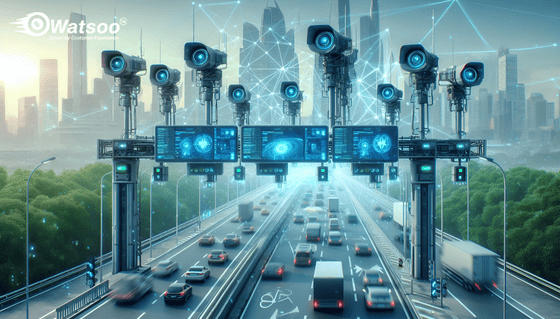A Smart Traffic Management System advancement in the city’s transportation management
Table of Contents
ToggleTransforms the way vehicles are managed on the roads. It is leveraged with artificial intelligence, Internet of Things, GPS-enabled sensors, video monitoring systems, cloud computing, data analytics, and other such technical techniques.
Avoid congestion and improve road security with upgradation. The blog includes information about the smart traffic management system using IoT, its advantages, features, development, demand, and technologies. Know why we are your advanced traffic management system solution provider in India 2025.
What is the Smart Traffic Management System?
An advanced traffic management system integrates interconnected devices, IoT-based sensors, and AI based traffic management systems and algorithms to control or monitor traffic in real-time. It enables predictive analysis with enhanced decision-making, which helps automate regular operations. The user can control signals and detect incidents to provide secure and smooth commutes.
The intelligent traffic management system dynamically adjusts signals by analysing the traffic patterns. If you wish to predict congestion while reducing travel times and improving road safety, you can trust Watsoo ATMS (Advanced Traffic Management System). It also helps in decreasing pollution, promoting green logistics, and prioritising emergency vehicles.
Development of an Advanced Traffic Management System
The STMS (Smart Traffic Management System) development involves technical integrations and infrastructure control. It focuses on creating intelligent, data-driven solutions that adapt to changing conditions and improve mobility for all transportation modes.
In India, the first artificial intelligence-based ATMS (Advanced Traffic Management System) was launched on Delhi’s Dwarka Expressway in 2025. This system, supervised by NHAI and developed by IHMCL, unified high-definition cameras, video incident detection, and automated enforcement of the guidelines.
Features of a Smart Traffic Management System using IoT
As a comprehensive tracking system solution, its infrastructure has numerous features. Many systems and software work together in coordination to provide faster, smarter and ultra-modern traffic handling solutions. The prominent ones are:
- AI-enabled PTZ (Pan, Tilt, and Zoom) Cameras
- VIDS-Based Automatic Incident Detection
- VMS-powered Roadside Displays
- Control Room and Communication Systems
- VSDS (Vehicle Speed Detection System)
- TMCS-enabled Traffic Flow Control
- Metrological Data System
- Priority to Emergency Vehicles
- ECB – Emergency Call Box Facility
- Vehicle Actuated Speed Displays (VASD) Speed Compliance
- NIC E-Challan Portal Integration
Advantages of an Advanced Traffic Management System
There are numerous advantages of a smart traffic management system using IoT for traffic flow. It provides data-driven information to operators for assisting in smart parking and route optimisation. The prominent benefits of this system are:
- Diminished Congestion and Commute Time
- Improves Road Safety
- Real-time Violation Detection
- Accelerated Emergency Response
- Centralised Controlled Infrastructure
- Enables Data-driven Policymaking
- Immediate Incident Analytics
- Minimises Manual Enforcement Inefficiencies
- Reduced Pollution and Air Quality Monitoring
Smart Traffic Management System using IoT Demand
The demand for an Intelligent Traffic Management System is increasing with urbanisation, rise in vehicle ownership, improved road safety, and the reduction of traffic congestion. This system provides huge support to smart cities and sustainable development projects. The system is in demand due to its technical advancements, which automate most of the processes.
It supports integrated mobility solutions such as Mobility-as-a-Service (MaaS). The demand for this system is escalating in Indian metro areas. Its facilities, for instance, enhanced compliance and traffic flow, inspiring adoption on highways and expressways.
Smart Technologies for Road Infrastructure and Traffic Management Systems
Road infrastructure and traffic management systems integrate smart technologies, i.e, interconnected sensors, AI based traffic management system, and modern devices like smart cameras to gather real-time data for analysis. It enables adaptive traffic signals, smart parking, advanced route guidance, and incident detection. Know about its key hardware and software components here.
Software
- AI-based Video Analytics
- Automated Violation Detection Systems
- Real-time Traffic Monitoring Dashboards
- Predictive Traffic Pattern Analysis Tools
- Integration with National E-Challan Systems
Hardware
- High-definition PTZ Cameras
- Speed Radars
- Variable Message Signboards (VMS)
- Vehicle Actuated Speed Displays (VASD)
- Centralised Command Centres
- IoT-connected Traffic Signals
The connected Vehicle (V2X) technology is used for interaction between vehicles and the infrastructure, making it an advanced solution for smart cities.
Advanced Traffic Management System Sensors and Devices
The smart devices and sensors play a vital role in a Smart Traffic Management System. It supports traffic flow monitoring, vehicle movement tracking, environment monitoring, and transfers the collected data to a centralised system. The primary sensors and devices used in this system are:
- AI-enabled HD Cameras
- Inductive Loop Detectors
- Wireless Sensor Networks (WSNs)
- Automatic Number Plate Recognition (ANPR) Cameras
- Bluetooth Sensors
- Environmental Monitoring Stations
- Emergency Vehicle Priority Systems
- Communication Technologies
- Speed Detection Radar Sensors
- Infrared and Motion Sensors for Vehicle Counting
An AI-Based Smart Traffic Management System Using Video Processing
The AI based traffic management system has integrated video processing advancements for faster incident detection (Overspeeding, accidents, triple riding, and other such happenings). Artificial intelligence algorithms modernise video feeds, real-time footage, timely alerts, and quicker responses, enhancing security.
Smart Traffic Management System using IoT: Connected Traffic Light & Control System
The feature of an STMS infrastructure involves auto-adjustment of cameras and sensors based on flow patterns and traffic density. The video sensors play a major role here as they constantly feed data to the centralised control centre, enabling adaptive coordination for peak hours and emergency circumstances.
Watsoo: Develop Your Intelligent Traffic Management System Smartly
For integrating a Smart Traffic Management System using IoT, you need a company that provides comprehensive traffic management services. Watsoo offers an ATMS (Advanced Traffic Management System) customised as per Indian road needs.
We are a superior choice as we have incorporated advanced artificial intelligence, video analytics, and IoT sensors into this system. You can monitor vehicles in real-time, automatically detect incidents, and achieve smooth integration for emergency services. Build a safer and smarter road with us.
Conclusion
Transform roadways infrastructure using the Smart Traffic Management System powered by an IoT and AI based traffic management system. Reduce congestion, develop sustainable urban mobility, enhance safety, and take inspiration from ATMS (Advanced Traffic Management System)-powered Dwarka Expressway.
Watsoo ATMS solutions could be a brilliant choice if you wish to integrate smart, modern technologies to avoid road congestion and take immediate action in case of an accident. Control traffic and optimise routes for a hassle-free road trip.
FAQs
Q. What is a smart traffic management system?
An Advanced Traffic Management System integrates IoT sensors, AI-based solutions, and connected sensors or devices. The solution is used for improved monitoring and management of vehicles on roads, and to optimise traffic flow for better efficiency and security.
Q. What is an example of traffic management?
A suitable example of an AI based traffic management system is the Dwarka Expressway in Delhi, which manages traffic through real-time analytics, smart cameras and automated administration.
Q. What tech is used in smart traffic systems?
For a smart traffic system, AI based video processing, speed radars, IoT sensors, PTZ cameras, Variable Message Signboards, and centralised centres develop the most basic infrastructure.
Q. How can AI improve traffic management in smart cities?
AI or artificial intelligence improves traffic management in smart cities by providing predictable traffic patterns and dynamically adjusting signal timing. You can use these advancements to detect regulatory violations and support emergency responses.
Q. Why Choose the Watsoo Advanced Traffic Management System in 2025?
We combine IoT, AI, and video analytics into our scalable ATMS platform developed for flexible, unique traffic challenges. Our intelligent system ensures faster incident management and smarter roads.


